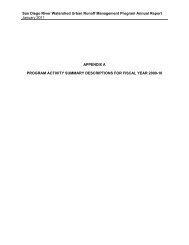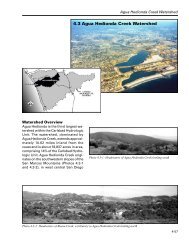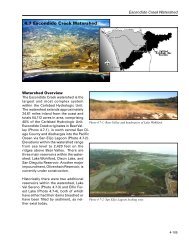APPENDIX I Toxicity Identification Evaluation Reports for Chollas ...
APPENDIX I Toxicity Identification Evaluation Reports for Chollas ...
APPENDIX I Toxicity Identification Evaluation Reports for Chollas ...
You also want an ePaper? Increase the reach of your titles
YUMPU automatically turns print PDFs into web optimized ePapers that Google loves.
<strong>Toxicity</strong> <strong>Identification</strong> <strong>Evaluation</strong> of Sweetwater<br />
River Stormwater Using Selenastrum<br />
capricornutum August 2006<br />
response of the control organisms. The test was considered invalid if the criterion of a cell<br />
density of 200,000 cells per mL in the control was not met. Variability between the control<br />
replicates should not have exceeded 20%. A reference toxicant test was conducted using<br />
copper sulfate with concentrations of 7, 14, 28, 56, and 112 µg Cu 2+ /L to establish the sensitivity<br />
of test organisms used in the evaluation of the Sweetwater stormwater.<br />
3.2 TEST SOLUTION PREPARATION<br />
Control and dilution water <strong>for</strong> the S. capricornutum tests was synthetic moderately-hard water<br />
prepared with Epure to achieve a hardness of 80-100 mg/L as CaCO3. This water source<br />
has been used successfully on numerous similar bioassay testing programs conducted by<br />
Weston and others. Extensive testing with a variety of species and biannual chemical analysis<br />
of this water type has shown that this water source provides <strong>for</strong> good survival in laboratory<br />
controls with little to no measurable levels of contaminants.<br />
3.3 WATER QUALITY<br />
Water quality was monitored daily as appropriate <strong>for</strong> each test, and data were recorded on data<br />
sheets. Dissolved oxygen and temperature was measured using Orion Model 840 oxygen<br />
meters and probes; pH was measured using Orion Model 230A pH meters and probes.<br />
Conductivity was measured with Orion Models 142 conductivity/salinity meters. Ammonia<br />
was analyzed using an Orion 720 digital ion analyzer with a three-point calibration curve (1,<br />
10, and 100 mg/L). Hardness and alkalinity were measured utilizing LaMotte titration kits.<br />
3.4 SAMPLE RECEIPT<br />
The stormwater samples were composited at the laboratory and stored at 4°C. A chain-ofcustody<br />
was completed <strong>for</strong> all samples received. Be<strong>for</strong>e samples were used in the tests, initial<br />
water quality measurements were taken. These measurements included temperature, total<br />
chlorine, total ammonia, pH, dissolved oxygen, and salinity.<br />
3.5 PHASE I TIE METHODS<br />
3.5.1 Protocol Modifications<br />
Measures to conserve time and resources required to conduct TIE testing have been developed<br />
and approved by the USEPA (USEPA 1992). This study incorporated modifications allowed <strong>for</strong><br />
reduction in number of test concentrations, and replicates <strong>for</strong> all TIE tests conducted, relative to<br />
test conditions used in standard toxicity tests. The concentrations of stormwater samples used<br />
<strong>for</strong> the TIE test in this investigation included the 50, 75, and 100% dilutions of the stormwater<br />
samples. Three replicates were used in each stormwater sample treatment. Treatment blanks<br />
were created <strong>for</strong> each TIE test to determine the effects of the manipulation on laboratory dilution<br />
water. The results of these blanks were used to determine if any changes in toxicity of the<br />
control (dilution water) were impacted by the chemical or physical manipulation of the sample.<br />
3.5.2 Baseline Tests<br />
The baseline test assesses the toxicity of the unmanipulated sample run concurrently with the<br />
TIE tests. This test would confirm the presence of toxicity in the stormwater sample, and toxicity<br />
in TIE treatments are compared to toxicity in the baseline test.<br />
3.5.3 Ethylenediaminetetraacetic Acid (EDTA) Tests<br />
Two series of EDTA tests were conducted with concentrations of 3.0 and 8.0 milligrams per liter<br />
(mg/L). A stock solution of 2.5 grams (g) EDTA/L was prepared. EDTA treatments were<br />
prepared by diluting the EDTA stock solution to final concentrations of 3.0 and 8.0 mg/L in<br />
stormwater (50, 75, and 100% sample concentrations) and dilution water. The EDTA was<br />
Weston Solutions, Inc. 6





